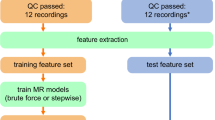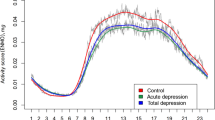Abstract
The aim of this study was to compare four time-zone activity rates over 24 h between melancholy type major depression (MMD) patients and normal subjects using actigraph. Ten patients diagnosed as suffering from MMD in the hospital attached to the Kinki University were the subjects of the present investigation. Another age-matched group of 10 normal healthy subjects with an approximate sex ratio were taken as controls. Subjects were each asked to consistently wear an actigraph on the wrist from the day of admittance to the day of discharge from the hospital, while the control group wore similar actigraphs over a 1-week period. Immediately after initiation of therapy (initial phase) for MMD (day 2 after admittance), until the relief phase (1 day before discharge), circadian activities were monitored with actigraphs at four time zones over a 24-h period: 06:00–12:00, 12:00–18:00, 18:00–24:00 and 00:00–06:00 hours. In the control group, similar procedures were followed to obtain parallel data. In the comparison of MMD patients with controls in the initial phase, the activity rates of the MMD group in the 12:00–18:00 hours zone were significantly higher than the control activity rates, and those of the 18:00–24:00 hours zone were lower than the control. When activity rates in the initial phase were compared with the relief phase in MMD patients, those of the initial phase were higher than the relief phase at 12:00–18:00 hours. In the disease-stage of MMD, activity rates of time-zones 12:00–18:00 hours are relatively high in affected patients. Based on actigraphy, an objective therapy criterion for assessing MMD may plausibly be established.
Similar content being viewed by others
References
Teicer MH. Actigraphy and motion analysis: new tools for psychiatry. Harv. Rev. Psychiatry 1995; 3: 18–35.
Sugimoto A, Hara Y, Findley TW, Yonemoto K. A useful method for measuring daily physical activity by a three-direction monitor. Scand. J. Rehabil. Med. 1997; 29: 37–42.
Evans BD, Rogers AE. 24-hour sleep/wake patterns in healthy elderly persons. Appl. Nurs. Res. 1994; 7: 75–83.
Young MP, Matumoto K, Yoo JS, Young RC, Tae EN. Sleep-wake behahavior of sift workers using wrist actigraph. Psychiatry Clin. Neurosci. 2000; 54: 359–60.
Kupfer DJ, Weiss BL, Foster FG, Detre TP, Delgado J, McPartland R. Psychomotor activity in affective states. Arch. Gen. Psychiatry 1974; 30: 765–8.
Teicer MH, Lawrence JM, Barber NI, Finkerstein SP, Lieberman HR, Baldessarini RJ. Circadian rhythm disturbances in geriatric major depression. Arch. Gen. Psychiatry 1988; 45: 913–17.
Benit O, Royant-Parola S, Borbely AA, Tobler I, Widolocher D. Circadian aspects of motor activity in depressed patients. Acta Psychiatr. Belg. 1985; 85: 582–92.
Lemke MR, Paul P, Broderick A. Motor activity and perception of sleep in depressed patients. J. Psychiatr. Res. 1999; 33: 215–24.
Stanley N, Fairweather DB, Hindmarch I. Effect of Fluoxetine and Dothepin on 24-hour activity in depressed patients. Neuropsychobiology 1999; 39: 44–8.
Hang HJ, Wirz-Justice A. Diurnal Variations of mood in depression: important or irrelevant. Biol. Psychiatry 1993; 34: 201–3.
Lemke MR, Broderick A, Zeiteberger M, Hartman W. Motor activity and daily variation of symptom intensity in depressed patient. Neuropsychobiology 1997; 36: 57–61.
Raoux N, Benoit O, Dantchev N et al. Circadian pattern of motor activity in major depressed patients undergoing antidepressant therapy: relationship between actigraphic measures and clinical course. Psychiatry Res. 1994; 52: 85–98.
Zung WWK. A self-rating depression scale. Arch. Gen. Psychiatry 1965; 12: 63–70.
American Psychiatry Association. Diagnostic and statistical manual of mental disorder: DSM-IV American Psychiatry Association, Arlington, VA, 1994.
Ueda T, Mukai T, Higashi M, Hitomi Y, Kirime E, Hitomi K. SDS and actigraphical evaluation of recovery process of depression. Acta Kinki Univ. 2003; 28: 75–9.
Tellenbach H. Zur situationspsychologischen Analyse des Volrfeldes endogener Manien. Jahrb Psychol. Psychotherapie u. med. Anthropol. 1965; 12: 174–91. (In German).
Sasano T, Watanabe S, Morisita S, Arima J, Katsuta Y, Shinkado H. A classification of depression through cluster analysis. Kawasakiigakkaishi (Japanese) 1987; 13: 260–5. (In Japanese).
Moffoot APR, Ocarroll RE, Bennie J et al. Diurnal variation of mood and neuropsychological function in major depresson with melancholia. J. Affect. Disord. 1994; 32: 257–69.
Ali IM. Long-term treatment with antidepressants in primary care. Psychiatry Bull. 1998; 22: 15–19.
Author information
Authors and Affiliations
Corresponding author
Rights and permissions
About this article
Cite this article
Ueda, T., Mukai, T., Higashi, M. et al. Evaluation of depression with actigraphy. Sleep Biol. Rhythms 3, 22–26 (2005). https://doi.org/10.1111/j.1479-8425.2005.00154.x
Accepted:
Published:
Issue Date:
DOI: https://doi.org/10.1111/j.1479-8425.2005.00154.x




